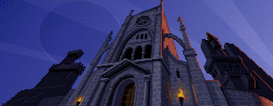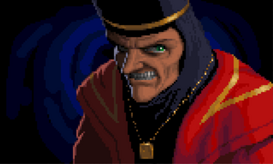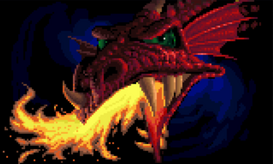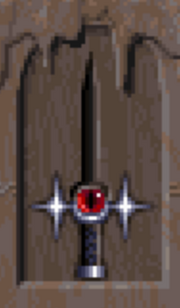However, if you can update it or further improve it, then please feel free to contribute.
Eye of the Beholder II: The Legend of Darkmoon is a computer game released in 1991. It was developed by Westwood Associates and published by Strategic Simulations, Inc. for Amiga, DOS, FM-Towns and PC-9800. It is the sequel to Eye of the Beholder.
Through a clearing in the haunted forest, three massive towers rise into the night sky — the dread Temple Darkmoon is just ahead! Like a siren, it inexorably draws you into its nightmarish depths...
The exciting sequel to Eye of the Beholder is here! Eye of the Beholder II: The Legend of Darkmoon is a graphically based AD&D computer fantasy role-playing saga. You'll love the stunning pictures, realistic animation and 3-D "you-are-there" point of view.
And EYE II gives you more — much more!
BIGGER! A bigger adventure includes forest, temple, catacomb and three huge towers. The bigger story gives you more people to meet, clues to learn and mysteries to unravel!
BETTER! Better graphics and improved "point-and-click" interface make playing even easier.
MEANER! There are lots of new, smarter, meaner monsters — some of the nastiest ones are human!
EYE OF THE BEHOLDER II. Bigger, better, meaner — and more of the best role-playing experience ever!
Plot[]

The evil temple of Darkmoon, where the adventurers explore and defeat Dran Draggore.
After the events that happened earlier in the year, the heroes head to a local inn to rest and enjoy their new found fame but a note gets slipped to them from the Archmage of Waterdeep, Khelben Arunsun, also known as Blackstaff. He says that he sent a scout to investigate reports of evil brewing in a temple known as Darkmoon but she has not returned.
Khelben then transports the heroes to the temple to find Amber and continue the investigation. While battling their way through the temple's clerics and other inhabitants, the players discover that the high priest, Dran Draggore, is assembling legions of skeletal warriors to attack Waterdeep. The players need to pass an acolytes' test to gain access to the inner parts of the temple. In the final confrontation Draggore turns out to be a red dragon.
Gameplay[]
The game a first-person dungeon-crawling role-playing game based on the second edition of AD&D rules. It uses the same point-and-click gameplay mechanics and controls as Eye of the Beholder. The game is set in a semi-3D maze with no auto-mapping. Combat flows in real time, and characters can move as a single unit to lure enemies or avoid blows.[1]
A starting party consists of four characters, which can be transferred from the earlier game or created from scratch. The player can choose from six classes. Characters can reach higher levels and learn new spells, must face new and tough monsters, and solve multiple puzzles. Compared to Eye of the Beholder, there are more NPC encounters and cutscenes were added.[1]
Index[]
Characters[]

Dran Draggore in his human form.

Dran Draggore reveals his true nature!
Referenced only
Bennet • Miltinda • Oltec • Wently Kelso • Xanathar
Creatures[]
Locations[]
Magic[]

Miscellaneous[]
Gallery[]
Credits[]
- DOS
- Director: Brett W. Sperry
- Design: Paul S. Mudra, Brett W. Sperry, Bill Stokes
- Art & Graphics: Joseph B. Hewitt IV, Louise Sandoval, Judith Peterson, Ren Olsen, Rick Parks, Aaron E. Powell
- Lead Programming: Phillip W. Gorrow
- Level Programmer (Westwood): Bill Stokes
- Amiga Programmer (Westwood): Bill Stokes
- Original Concept: Phillip W. Gorrow, Brett W. Sperry
- Intro & Finale: Joseph Bostic
- Music: Frank Klepacki
- Sound: Paul S. Mudra, Dwight Kenichi Okahara
- Writer: Marc Cram
- Quality Assurance: Glenn Sperry
- PC-9800
- Director: Brett W. Sperry
- Writer: Marc Cram
- Original Concept: Phillip W. Gorrow, Brett W. Sperry
- Design: Brett W. Sperry, Paul S. Mudra, Bill Stokes
- Art & Graphics: Rick Parks, Aaron E. Powell, Joseph B. Hewitt IV, Ren Olsen, Louise Sandoval, Judith Peterson
- Lead Programmer: Phillip W. Gorrow
- Level Programmer: Bill Stokes
- Amiga Programmer: Bill Stokes
- Intro & Finale: Joseph Bostic
- Music: Frank Klepacki
- Sound Effects: Paul S. Mudra, Dwight Kenichi Okahara
- Quality Assurance: Glenn Sperry
Appendix[]
Further Reading[]
- Hartley Lesser, Patricia Lesser and Kirk Lesser (March 1992). “The Role of Computers: Review: Eye of the Beholder II: The Legend of Darkmoon”. In Roger E. Moore ed. Dragon #179 (TSR, Inc.), pp. 59–60.
- Hartley Lesser, Patricia Lesser and Kirk Lesser (November 1992). “The Role of Computers: Clue Corner: Eye of the Beholder II: The Legend of Darkmoon”. In Roger E. Moore ed. Dragon #187 (TSR, Inc.), p. 63.
- Susan Manley (2015-10-16). Discovering the Gold Box (Web). In Matt Chapman ed. Dragon+ #4. Wizards of the Coast. p. 5. Retrieved on 2018-05-23.
External Links[]
 Eye of the Beholder II: The Legend of Darkmoon article at Wikipedia, The Free Encyclopedia.
Eye of the Beholder II: The Legend of Darkmoon article at Wikipedia, The Free Encyclopedia.
References[]
- ↑ 1.0 1.1 Eye of the Beholder II: The Legend of Darkmoon. Retrieved on 2018-01-12.
Connections[]
Other settings
Al-Qadim: The Genie's Curse • Planescape: Torment (Enhanced Edition) • Ravenloft: Stone Prophet • Ravenloft: Strahd's Possession • Spelljammer: Pirates of Realmspace
Collaborations
Dragonheir: Silent Gods • Stumble Guys
| Eye of the Beholder series | |
| Dungeons & Dragons: Eye of the Beholder • Eye of the Beholder • Eye of the Beholder II: The Legend of Darkmoon • Eye of the Beholder III: Assault on Myth Drannor | |



